Intel Rocket Lake (14nm) Review: Core i9-11900K, Core i7-11700K, and Core i5-11600K
by Dr. Ian Cutress on March 30, 2021 10:03 AM EST- Posted in
- CPUs
- Intel
- LGA1200
- 11th Gen
- Rocket Lake
- Z590
- B560
- Core i9-11900K
CPU Tests: Encoding
One of the interesting elements on modern processors is encoding performance. This covers two main areas: encryption/decryption for secure data transfer, and video transcoding from one video format to another.
In the encrypt/decrypt scenario, how data is transferred and by what mechanism is pertinent to on-the-fly encryption of sensitive data - a process by which more modern devices are leaning to for software security.
Video transcoding as a tool to adjust the quality, file size and resolution of a video file has boomed in recent years, such as providing the optimum video for devices before consumption, or for game streamers who are wanting to upload the output from their video camera in real-time. As we move into live 3D video, this task will only get more strenuous, and it turns out that the performance of certain algorithms is a function of the input/output of the content.
HandBrake 1.32: Link
Video transcoding (both encode and decode) is a hot topic in performance metrics as more and more content is being created. First consideration is the standard in which the video is encoded, which can be lossless or lossy, trade performance for file-size, trade quality for file-size, or all of the above can increase encoding rates to help accelerate decoding rates. Alongside Google's favorite codecs, VP9 and AV1, there are others that are prominent: H264, the older codec, is practically everywhere and is designed to be optimized for 1080p video, and HEVC (or H.265) that is aimed to provide the same quality as H264 but at a lower file-size (or better quality for the same size). HEVC is important as 4K is streamed over the air, meaning less bits need to be transferred for the same quality content. There are other codecs coming to market designed for specific use cases all the time.
Handbrake is a favored tool for transcoding, with the later versions using copious amounts of newer APIs to take advantage of co-processors, like GPUs. It is available on Windows via an interface or can be accessed through the command-line, with the latter making our testing easier, with a redirection operator for the console output.
We take the compiled version of this 16-minute YouTube video about Russian CPUs at 1080p30 h264 and convert into three different files: (1) 480p30 ‘Discord’, (2) 720p30 ‘YouTube’, and (3) 4K60 HEVC.
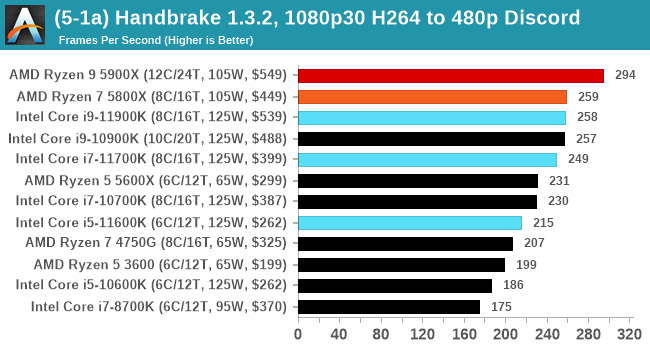
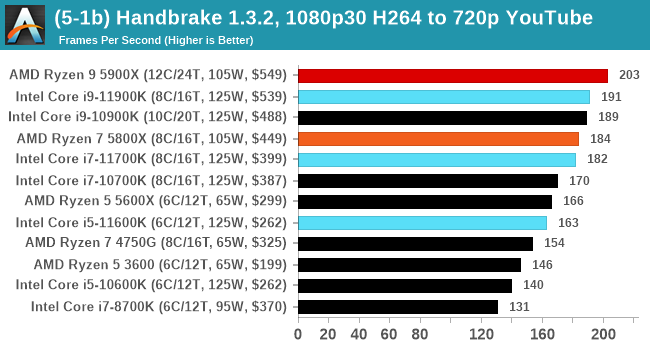
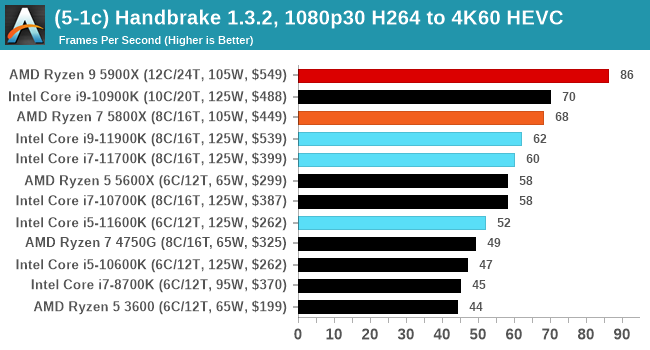
Up to the final 4K60 HEVC, in CPU-only mode, the Intel CPU puts up some good gen-on-gen numbers.
7-Zip 1900: Link
The first compression benchmark tool we use is the open-source 7-zip, which typically offers good scaling across multiple cores. 7-zip is the compression tool most cited by readers as one they would rather see benchmarks on, and the program includes a built-in benchmark tool for both compression and decompression.
The tool can either be run from inside the software or through the command line. We take the latter route as it is easier to automate, obtain results, and put through our process. The command line flags available offer an option for repeated runs, and the output provides the average automatically through the console. We direct this output into a text file and regex the required values for compression, decompression, and a combined score.
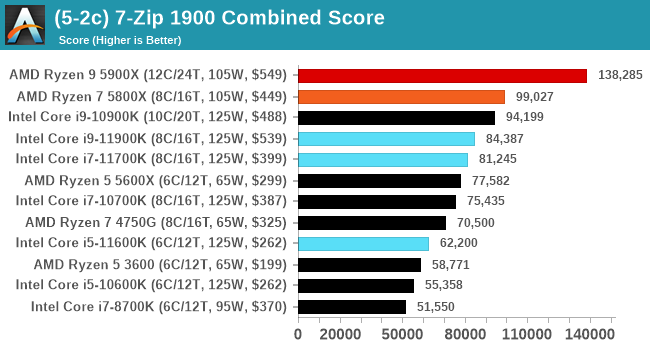
AES Encoding
Algorithms using AES coding have spread far and wide as a ubiquitous tool for encryption. Again, this is another CPU limited test, and modern CPUs have special AES pathways to accelerate their performance. We often see scaling in both frequency and cores with this benchmark. We use the latest version of TrueCrypt and run its benchmark mode over 1GB of in-DRAM data. Results shown are the GB/s average of encryption and decryption.
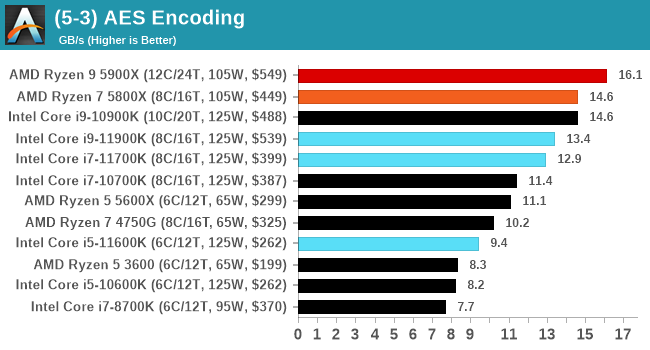
WinRAR 5.90: Link
For the 2020 test suite, we move to the latest version of WinRAR in our compression test. WinRAR in some quarters is more user friendly that 7-Zip, hence its inclusion. Rather than use a benchmark mode as we did with 7-Zip, here we take a set of files representative of a generic stack
- 33 video files , each 30 seconds, in 1.37 GB,
- 2834 smaller website files in 370 folders in 150 MB,
- 100 Beat Saber music tracks and input files, for 451 MB
This is a mixture of compressible and incompressible formats. The results shown are the time taken to encode the file. Due to DRAM caching, we run the test for 20 minutes times and take the average of the last five runs when the benchmark is in a steady state.
For automation, we use AHK’s internal timing tools from initiating the workload until the window closes signifying the end. This means the results are contained within AHK, with an average of the last 5 results being easy enough to calculate.
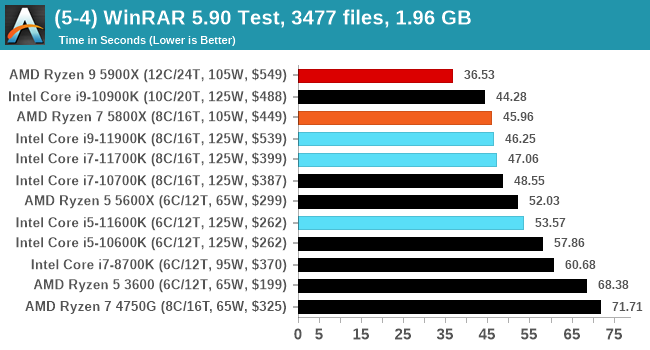
CPU Tests: Synthetic
Most of the people in our industry have a love/hate relationship when it comes to synthetic tests. On the one hand, they’re often good for quick summaries of performance and are easy to use, but most of the time the tests aren’t related to any real software. Synthetic tests are often very good at burrowing down to a specific set of instructions and maximizing the performance out of those. Due to requests from a number of our readers, we have the following synthetic tests.
Linux OpenSSL Speed: SHA256
One of our readers reached out in early 2020 and stated that he was interested in looking at OpenSSL hashing rates in Linux. Luckily OpenSSL in Linux has a function called ‘speed’ that allows the user to determine how fast the system is for any given hashing algorithm, as well as signing and verifying messages.
OpenSSL offers a lot of algorithms to choose from, and based on a quick Twitter poll, we narrowed it down to the following:
- rsa2048 sign and rsa2048 verify
- sha256 at 8K block size
- md5 at 8K block size
For each of these tests, we run them in single thread and multithreaded mode. All the graphs are in our benchmark database, Bench, and we use the sha256 results in published reviews.
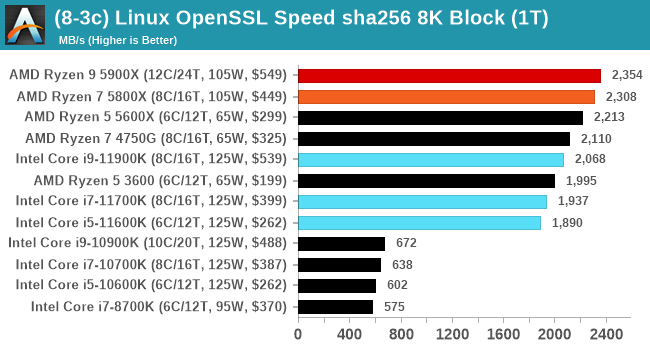
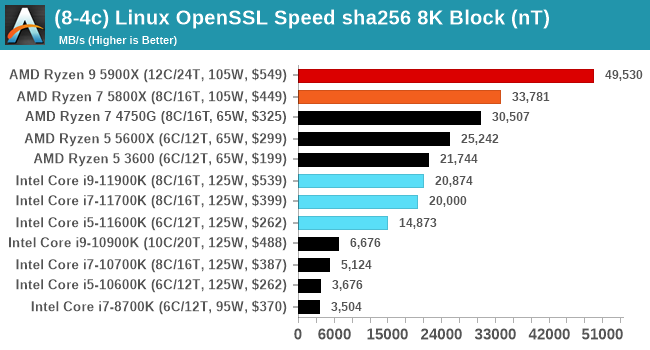
Intel comes back into the game in our OpenSSL sha256 test as the AVX512 helps accelerate SHA instructions. It still isn't enough to overcome the dedicated sha256 units inside AMD.
CPU Tests: Legacy and Web
In order to gather data to compare with older benchmarks, we are still keeping a number of tests under our ‘legacy’ section. This includes all the former major versions of CineBench (R15, R11.5, R10) as well as x264 HD 3.0 and the first very naïve version of 3DPM v2.1. We won’t be transferring the data over from the old testing into Bench, otherwise it would be populated with 200 CPUs with only one data point, so it will fill up as we test more CPUs like the others.
The other section here is our web tests.
Web Tests: Kraken, Octane, and Speedometer
Benchmarking using web tools is always a bit difficult. Browsers change almost daily, and the way the web is used changes even quicker. While there is some scope for advanced computational based benchmarks, most users care about responsiveness, which requires a strong back-end to work quickly to provide on the front-end. The benchmarks we chose for our web tests are essentially industry standards – at least once upon a time.
It should be noted that for each test, the browser is closed and re-opened a new with a fresh cache. We use a fixed Chromium version for our tests with the update capabilities removed to ensure consistency.
Mozilla Kraken 1.1
Kraken is a 2010 benchmark from Mozilla and does a series of JavaScript tests. These tests are a little more involved than previous tests, looking at artificial intelligence, audio manipulation, image manipulation, json parsing, and cryptographic functions. The benchmark starts with an initial download of data for the audio and imaging, and then runs through 10 times giving a timed result.
We loop through the 10-run test four times (so that’s a total of 40 runs), and average the four end-results. The result is given as time to complete the test, and we’re reaching a slow asymptotic limit with regards the highest IPC processors.

Google Octane 2.0
Our second test is also JavaScript based, but uses a lot more variation of newer JS techniques, such as object-oriented programming, kernel simulation, object creation/destruction, garbage collection, array manipulations, compiler latency and code execution.
Octane was developed after the discontinuation of other tests, with the goal of being more web-like than previous tests. It has been a popular benchmark, making it an obvious target for optimizations in the JavaScript engines. Ultimately it was retired in early 2017 due to this, although it is still widely used as a tool to determine general CPU performance in a number of web tasks.
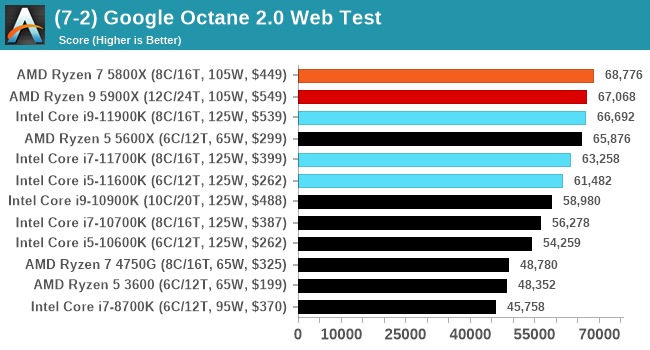
Speedometer 2: JavaScript Frameworks
Our newest web test is Speedometer 2, which is a test over a series of JavaScript frameworks to do three simple things: built a list, enable each item in the list, and remove the list. All the frameworks implement the same visual cues, but obviously apply them from different coding angles.
Our test goes through the list of frameworks, and produces a final score indicative of ‘rpm’, one of the benchmarks internal metrics.
We repeat over the benchmark for a dozen loops, taking the average of the last five.
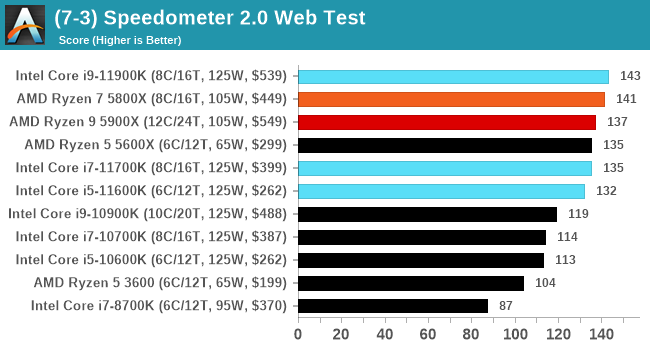
Legacy Tests
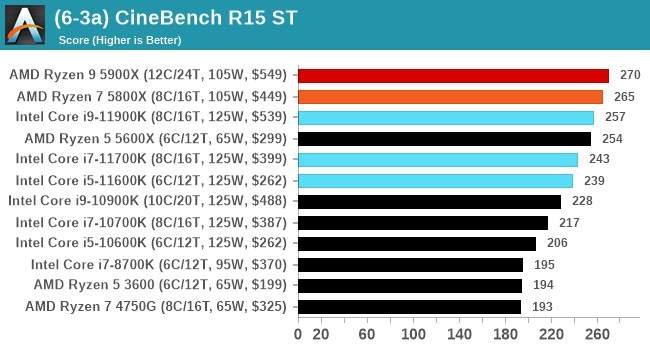

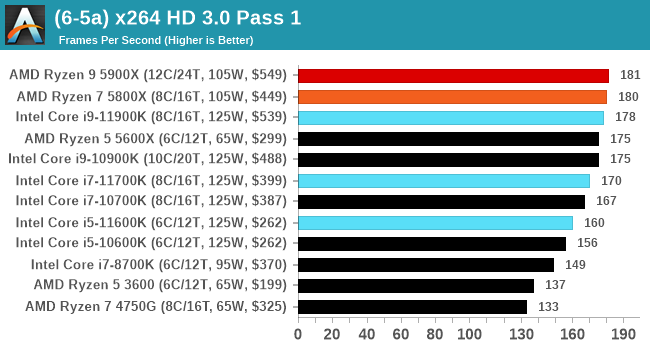
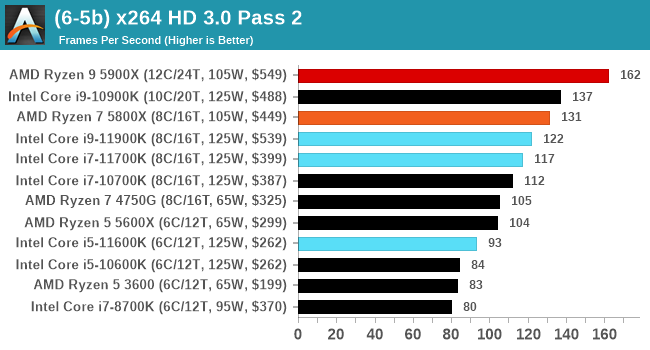


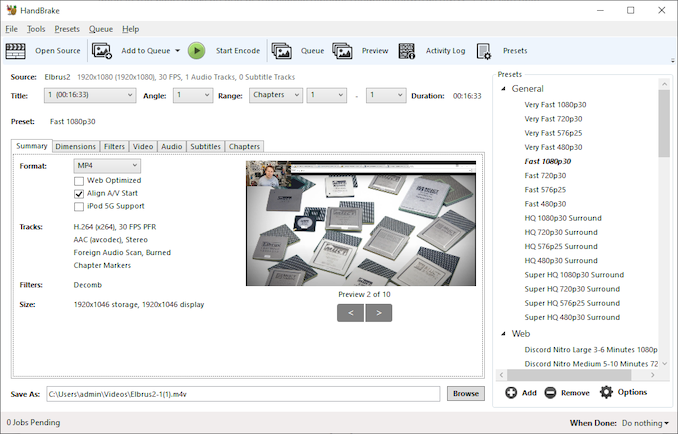
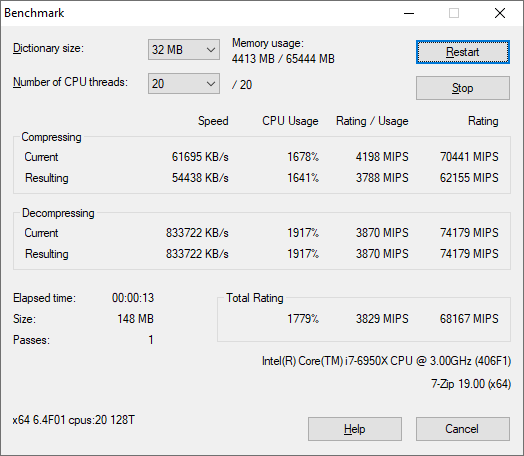
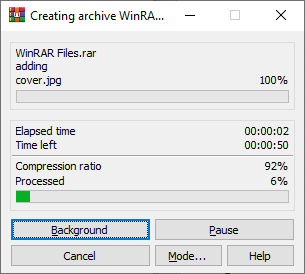

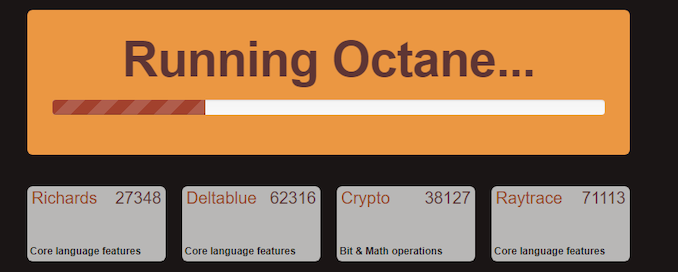
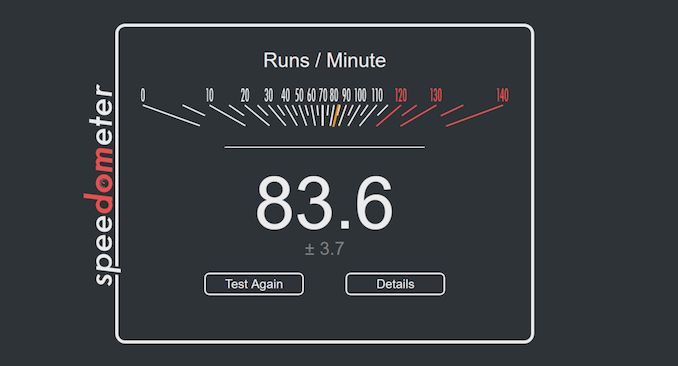








279 Comments
View All Comments
GeoffreyA - Tuesday, March 30, 2021 - link
It could be due to x264 limiting the number of threads because when vertical resolution divided by threads drops below a certain threshold---I think round about 30 or 40---quality begins to suffer.GeoffreyA - Wednesday, March 31, 2021 - link
I tested this now on FFmpeg but it should be the same on Handbrake because the x264/5 libraries are doing the actual encoding.I only have a 4C/4T CPU but used the "-threads" switch to request more. On x264, regardless of resolution, once more than 16 threads are asked for, it logs a warning that it's not recommended but goes ahead and uses the requested count, up to 128. I assume that running at default settings, like AT is probably doing with Handbrake, will let x264 cut off at 16 by itself. If someone could confirm this with a 32-thread CPU, that would be nice. As for x265, I gave it a try as well and the encoder refuses to go on if more than 16 threads are requested, saying the range must be between 0 and X265_MAX_FRAME_THREADS.
In short, I reckon both these codecs are cutting off at 16 threads on default settings. If Ian or someone else could test how much extra is gained by manually putting in the count on a 32T CPU, that would be interesting.
scott_htpc - Tuesday, March 30, 2021 - link
Splat. Backporting doesn't really work & dead-end platform.What I'd really like to read is a detailed narrative of Intel's blunders over the last 5-10 years. To me, it probably makes a case study in failed leadership & hubris, but I would really like to read an authoritative, detailed account. I'm curious why the risks of their decisions were not enough to dissuade them to take a better path forward.
Prosthetic Head - Tuesday, March 30, 2021 - link
Yes, some sort of post mortem on Intel development over the last few years would be interesting. Once they abandoned the Pentium 4 madness, they did a good job with Core, Core2 and then the early stages of the 'i' series. Because AMD were by that point down their own dead end, they had essentially no competition for about a decade. The tempting easy explanation is that as a de facto monopoly for desktop and laptop CPUs, they only innovated enough to keep the upgrade cycle ticking over, then when AMD made a rapid comeback they got caught with their pants down and some genuine technical difficulties in fab tech.... But the reality could be a lot more complex and interesting than that.Hifihedgehog - Tuesday, March 30, 2021 - link
> But the reality could be a lot more complex and interesting than that.The reality is Conroe was a once-in-a-lifetime IPC improvement, literally 90% better (or nearly double the performance!) clock-for-clock than the ill-fated Pentium 4 (see here: https://www.reddit.com/r/intel/comments/m7ocxj/pen... They are not going to get that again unless Gelsinger clones himself across Intel's entire leadership team. Now, they may get something Zen-like in the ~50% range, but nothing Conroe-like unless ALL the stars align after a decade of complacency.
Hifihedgehog - Tuesday, March 30, 2021 - link
https://www.reddit.com/r/intel/comments/m7ocxj/pen...29a - Tuesday, March 30, 2021 - link
Keep in mind that P4 was a piece of shit built for marketing high clock speeds and was easily beaten by Athlon 64 running 1Ghz slower so getting that much IPC wasn't as hard as usual.GeoffreyA - Wednesday, March 31, 2021 - link
"Keep in mind that P4 was a piece of"Not to defend the P4, but Northwood wasn't half bad in the Athlon XP's time, beating it quite a lot. It was Prescott that mucked it all up.
TheinsanegamerN - Wednesday, March 31, 2021 - link
TBF, the only reason it wasnt half bad is AMD's willingness to just abandon XP. I mean, only 2.23 GHz? 3 GHz OCs were not hard to do with their mobile lineup, and those obliterated anything intel would have until conroe. IF they had released 2.4, 2.6, and 2.8 GHz athlon XPs intel would have been losing every benchmark against them.GeoffreyA - Friday, April 2, 2021 - link
Oh yes, the XP had the higher IPC and would have given Intel a sound drubbing if its clocks were only higher. Thankfully, the Athlon 64 came and turned the tables round. I remember in those days my heart was set on the 3200+ Barton but I ended up with a K8 budget system of sorts.